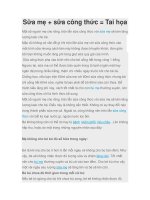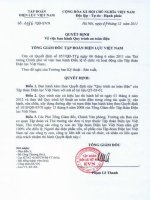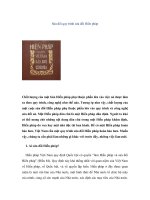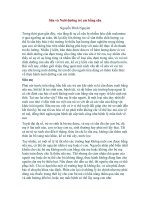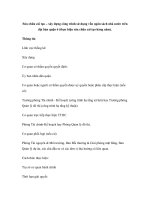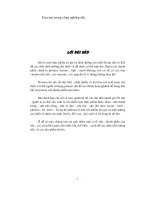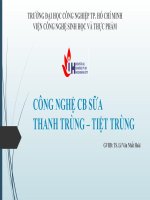sữa và các sản phẩm từ sữa
Bạn đang xem bản rút gọn của tài liệu. Xem và tải ngay bản đầy đủ của tài liệu tại đây (2.31 MB, 59 trang )
MINISTRY OF EDUCATION AND TRAINING
HO CHI MINH CITY UNIVERSITY OF TECHNOLOGY AND EDUCATION
FACULTY FOR HIGH QUALITY TRAINING
Major: FOOD TECHNOLOGY
Subject: PRACTICE OF DAIRY AND RELATED
DAIRY PRODUCTION
Report: Practice of Dairy and Related
Dairy Production
GROUP 2
1. Nguyen Thuy Thanh Hien
ID: 18116015
2. Chu Le Thu Huyen
ID: 18116017
3. To Que Phung
ID: 18116028
4. Nguyen Thi Minh Thu
ID: 18116038
5. Tran Bao Thanh Truc
ID: 18116040
Semester: 1 – School year: 2021 – 2022
Lecturer: Dr. Pham Thi Hoan
Class: 18116CLA, Saturday, lesson 1 – 12
Ho Chi Minh City, December 2021
Table of Contents
LIST OF FIGURES ...................................................................................................... iv
LIST OF TABLES ........................................................................................................ vi
LIST OF ABBREVIATIONS .....................................................................................vii
EXPERIMENT 1. EVALUATION OF MILK AND RECONSTITUTED MILK
QUALITY....................................................................................................................... 8
Abstract ....................................................................................................................... 8
1.1. Introduction ......................................................................................................... 8
1.2. Materials and methods ....................................................................................... 9
1.3. Result and discussion ........................................................................................ 13
1.3.1. Sensory evaluation of the five samples ........................................................ 13
1.3.2. Milk density ................................................................................................. 15
1.3.3. Acid titration ................................................................................................ 15
1.3.4. pH measurement........................................................................................... 16
1.3.5. Alcohol test .................................................................................................. 16
1.3.6. Methylene blue test ...................................................................................... 17
1.4. Conclusion ......................................................................................................... 18
Reference .................................................................................................................. 18
EXPERIMENT 2. YOGURT PRODUCTION ........................................................... 2
Abstract ....................................................................................................................... 2
2.1. Introduction ......................................................................................................... 2
2.1.1. Definition of yogurt........................................................................................ 2
2.1.2. Origin of yogurt.............................................................................................. 3
2.1.3. Classification .................................................................................................. 3
2.1.4. Yogurt consumption situation in some countries around the world .............. 4
2.2. Materials and methods ....................................................................................... 4
2.2.1. Materials ......................................................................................................... 4
2.2.2. Methods .......................................................................................................... 8
2.3. Result and discussion ........................................................................................ 12
2.3.1. Sensory evaluation ....................................................................................... 12
2.3.2. pH and titratable acidity (TA) measurement................................................ 13
2.4. Conclusion ......................................................................................................... 15
Reference .................................................................................................................. 15
EXPERIMENT 3. CHEESE PRODUCTION .......................................................... 18
ii
Abstract ..................................................................................................................... 18
3.1. Introduction ....................................................................................................... 18
3.1.1. Definition and classification of cheese ........................................................ 18
3.1.2. Mozzarella cheese ........................................................................................ 19
3.2. Materials and methods ..................................................................................... 20
3.2.1. Materials ....................................................................................................... 20
3.2.2. Methods ........................................................................................................ 23
3.3. Result and discussion ........................................................................................ 29
3.3.1. Sensory evaluation ....................................................................................... 29
3.3.2. Determination of cheese solid yield (CSY) and total solid (TS) of cheese . 29
3.3.3. Determination of cheese yield efficiency..................................................... 30
3.4. Conclusion ......................................................................................................... 31
Reference .................................................................................................................. 31
EXPERIMENT 4. ICE CREAM PRODUCTION ................................................... 33
Abstract ..................................................................................................................... 33
1.1. Introduction ....................................................................................................... 33
4.1.1. Definition of ice cream................................................................................. 33
4.1.2. Origin of ice cream....................................................................................... 33
4.1.3. Classification ................................................................................................ 34
1.2. Materials and methods ..................................................................................... 34
1.2.1. Materials ..................................................................................................... 34
1.2.2. Methods ....................................................................................................... 36
1.3. Result and discussion ........................................................................................ 39
4.1.4. Sensory evaluation ....................................................................................... 39
4.1.5. Determination of overrun ............................................................................. 40
1.4. Conclusion ......................................................................................................... 40
Reference .................................................................................................................. 40
iii
LIST OF FIGURES
Figure 1.1. Sterilled Vinamilk ........................................................................................ 9
Figure 1.2. Nong Lam pasteurized milk ....................................................................... 10
Figure 1.3. Long Thanh pasteurized milk..................................................................... 10
Figure 1.4. Whole cream milk powder ......................................................................... 10
Figure 1.5. Balling hydrometer..................................................................................... 11
Figure 1.6. How to read a value in a balling hydrometer ............................................. 12
Figure 1.7. State of unexpired, expired sterilized Vinamilk, Nong Lam milk, Long
Thanh milk and reconstituted milk (from left to right) ................................................. 14
Figure 1.8. Results of methylene blue test for expired and unexpired sterilized
Vinamilk ........................................................................................................................ 17
Figure 2.2. Yogurt........................................................................................................... 3
Figure 2.3. The chart on annual yogurt consumption in a certain nation ....................... 4
Figure 2.4. Dutch Lady ................................................................................................... 5
Figure 2.5. Whole cream milk powder ........................................................................... 7
Figure 2.6. The starter culture used in this experiment .................................................. 7
Figure 2.7. The technological process of 2 different set yogurt samples ....................... 8
Figure 2.8. Pasteurization of milk after standardizing ................................................... 9
Figure 2.9. Samples were filled into jars ...................................................................... 10
Figure 2.10. pH-meter................................................................................................... 11
Figure 2.11. Phenolphtalein chemical structure ........................................................... 11
Figure 2.12. Color transformation during titration ....................................................... 12
Figure 2.13. Yogurt product after cooling within 12 hours made of raw liquid milk
(left) and reconstituted milk (right) ............................................................................... 12
Figure 2.14. Relationship between pH and titratable acidity of the 2 samples ............ 15
Figure 3.1. Cottage cheese ............................................................................................ 19
Figure 3.3. Mozzarella cheese ...................................................................................... 20
Figure 3.4. Nong Lam Milk .......................................................................................... 20
Figure 3.6. Chemical structure of citric acid ................................................................ 21
Figure 3.7. Citric acid ................................................................................................... 21
Figure 3.9. Rennet enzyme ........................................................................................... 22
Figure 3.10. Flow chart of mozzarella cheese processing ............................................ 23
Figure 3.11. Nong Lam raw liquid milk ....................................................................... 24
Figure 3.12. Citric acid 6% addition............................................................................. 24
Figure 3.13. Rennet enzyme addition ........................................................................... 25
Figure 3.14. Milk coagulation after 15 minutes ........................................................... 26
Figure 3.15. Diagram of change of milk coagulation ................................................... 26
Figure 3.16. Curd cutting .............................................................................................. 27
Figure 3.17. Cheese kneading ....................................................................................... 28
Figure 3.18. Product in molding ................................................................................... 28
Figure 4.1. Ice cream .................................................................................................... 33
Figure 4.2. VINAMILK UHT non-sugar milk ............................................................. 34
Figure 4.3. Whipping cream Anchor ............................................................................ 35
iv
Figure 4.4. Egg yolk ..................................................................................................... 35
Figure 4.5. Flow chart of ice cream production ........................................................... 36
Figure 4.6. Egg yolk was stirred by hand beater .......................................................... 37
Figure 4.7. Ice cream machine ...................................................................................... 38
Figure 4.8. Overrun affects ice cream product ............................................................. 38
Figure 4.9. Hard ice cream ........................................................................................... 39
v
LIST OF TABLES
Table 1.1. Gross composition off milk from different mammals ................................... 8
Table 1.2. Sensory standards of milk (TCVN 7405:2018) ........................................... 11
Table 1.3. Results of samples after conducting organoleptic test................................. 14
Table 1.4. Results of milk density ................................................................................ 15
Table 1.5. Images of titrated solution ........................................................................... 15
Table 1.6. Acidity of milk samples ............................................................................... 16
Table 1.7. pH values result ........................................................................................... 16
Table 1.8. Results of alcohol test for milk samples ...................................................... 16
Table 2.1. Sensory criteria .............................................................................................. 5
Table 2.2. Physical and chemical criteria ....................................................................... 5
Table 2.3. Heavy metal content ...................................................................................... 6
Table 2.4. Microbiological indicators ............................................................................. 6
Table 2.5. Recipe of set yogurt ....................................................................................... 8
Table 2.6. Sensory properties of 2 surveyed yogurt samples ....................................... 12
Table 2.7. Color of titratable acidity for the 2 samples ................................................ 13
Table 2.8. pH and titratable acidity values of 2 surveyed samples............................... 13
Table 3.1. Recipe of Mozzarella cheese ....................................................................... 23
Table 3.2. Total solid of milk ....................................................................................... 29
Table 3.3. Total solid of cheese .................................................................................... 30
Table 4.1. Recipe of coffee ice cream .......................................................................... 36
Table 4.2. Sensory parameters of edible ices cream ..................................................... 38
Table 4.3. Sensory evaluation of finished product ....................................................... 39
vi
LIST OF ABBREVIATIONS
BC
Before Christ
CSY
Cheese Solid Yield
TA
Titratable Acidity
TS
Total Solid
UHT
Ultra-High Temperature
vii
EXPERIMENT 1. EVALUATION OF MILK AND RECONSTITUTED
MILK QUALITY
Abstract
Milk testing and quality control are critical components of every milk processing
enterprise, whether small, medium, or big. In this experiment, several tests were
conducted to assess milk quality from particular sources: Unexpired sterilized
Vinamilk and Expired sterilized Vinamilk, Nong Lam pasteurized milk, Long Thanh
pasteurized milk and reconstituted milk with 13% total solids. As a result, sensory
properties of different milk source were different from each other. Density of
unexpired Vinamilk and reconstituted milk is 1025 kg/m3, that of expired Vinamilk
is 1030 kg/m3. Titratable acidity of both expired and unexpired samples are the same
19.26oD, while that of reconstituted milk is 11.28oD. pH values of expired and
unexpired Vinamilk are 6.89 ± 0.0058 and 7.30 ± 0.0058 for reconstituted milk.
Alcohol test and methylene blue test proved that all milk samples are well-qualified
despite some errors of incomplete reconstitution and external microorganism
spoilage.
1.1. Introduction
Milk is a fluid secreted by the female of all mammalian species, of which there are
about 4500 extant species (about 80% of mammalian species are extinct) (Fox, P.F.
and McSweeney, P.L.H., 1998). Milk is defined as the secretion of the mammary
glands of mammals, its primary natural function being nutrition of the young. It is
derived from lactating mammals such as cows, sheep, goats, horses, buffaloes, etc. The
principal requirements are for energy (supplied by lipids and lactose and, when in
excess, by proteins), essential amino acids and amino groups for the biosynthesis of
non-essential amino acids (supplied by proteins), essential fatty acids, vitamins,
inorganic elements and water.
Different kinds of mammals, the chemical components are unsimilar, the differ are
present in Table 1.1.
Milk is a very complex fluid containing several hundred molecular species (several
thousand if all triglycerides are counted individually). The principal constituents are
water, lipids, sugar (lactose) and proteins. In addition, there are numerous minor
constituents, mostly at trace levels, e.g. minerals, vitamins, hormones, enzymes and
miscellaneous compounds. The chemistry of these compounds is generally similar
across species but in many cases their structure differs in detail, reflecting evolutionary
(Fox, P.F. and McSweeney, P.L.H., 1998).
Table 1.1. Gross composition off milk from different mammals
8
Milk is often described as the most ‘nearly perfect’ food; although this is true only
for the young of the producing or closely related species, the milk of all species is a
nutrient rich and well-balanced food (Kon, S. K., 1959; du Puis , E. M., 2002; Patton,
S., 2004 ). However, milk is very susceptible to the growth of micro-organisms, which
will cause spoilage if the milk is stored.
1.2. Materials and methods
1.2.1.1. Materials
❖ Samples preparation
Unexpired sterilized Vinamilk and Expired sterilized Vinamilk (5-month expired
milk, but not being opened and stored in refrigerator) from Vietnam Dairy Products
Joint Stock Company.
Figure 1.1. Sterilled Vinamilk
Nong Lam pasteurized milk from Nong Lam University, Thu Duc City, Ho Chi
Minh City.
9
Figure 1.2. Nong Lam pasteurized milk
Long Thanh pasteurized milk from LOTHAMILK Joint Stock Company, Bien Hoa
City.
Figure 1.3. Long Thanh pasteurized milk
Whole cream milk powder.
Figure 1.4. Whole cream milk powder
From whole milk powder with 4% moisture, preparing 500 mL reconstituted milk
with 13% dry matter by dissolving 67.71 g whole milk powder into 432.29 mL boiled
10
water. Reconstituting thoroughly by vigorous agitation and allow to stand for about 30
mins.
1.2.1.2. Methods
❖ Sensory evaluation of the five samples
At the milk receiving platform, the organoleptic test allows for quick separation of
low-quality milk. There is no need for special equipment, but the milk grader must
have excellent vision, smell, and taste. The test results are available immediately, and
the cost of the test is minimal.
Sensory evaluation is focused on the criteria of color, taste, state and texture of milk
as well as checking the milk samples if they contain any visual foreign matter or not in
the following 4 milk samples: Unexpired sterilized Vinamilk, Expired sterilized
Vinamilk, Long Thanh milk and Nong Lam milk.
Table 1.2. Sensory standards of milk (TCVN 7405:2018)
Criteria
Description
Color
From ivory white to light cream color
Flavor
Milk must have a natural characteristic
aroma and taste of fresh milk, without any
strange odors or tastes
State
Homogeneous mixture, no delamination
Foreign impurities visible to the
eyes
Must not present
Opening a can of milk, immediately smell the milk. Observing the appearance of the
milk. If still unable to make a clear judgement, taste the milk, but do not swallow it.
Spitting the milk sample into a bucket provided for that purpose or into a drain basin,
flush with water. Looking at the can lid and the milk can to check cleanliness.
❖ Milk density
According to TCVN 7405:2018, using a balling hydrometer to determine the density
of milk.
Figure 1.5. Balling hydrometer
11
The hydrometer works on the principle of Acsimeter repulsion. A solid suspended
in a liquid will rise with a force equivalent to the weight of the liquid displaced by the
submerged portion of the suspended solid. This force is in the same direction and
opposite direction with gravity. The lower the density of the liquid, the lower the
hydrometer of a given weight and vice versa. An object will float when its ‘synthetic
specific gravity’ is less than the specific gravity of water. Hydrometer sinks deeper in
gasoline, kerosene, alcohol and floats more in salt water, milk or acid.
Preparing a measuring cylinder with a capacity of 250 mL. Slowly pour the milk
sample into the cup. This measuring cylinder should be placed on a smooth, nonshaking surface. Dropping the hydrometer gently into the liquid, wait until the
hydrometer balances, stop moving inside the liquid. The position where the surface of
the milk touches the body of the hydrometer will be the result to be measured.
Hydrometers can take any value, depending on the properties that correlate with the
density of that liquid.
Figure 1.6. How to read a value in a balling hydrometer
❖ Acid titration
The quantification of lactic acid produced from the fermentation of lactose by the
action of lactic acid fermentation bacteria in milk. On the other hand, allowing to
determine the acidity of milk (detecting milk with added water or abnormal milk).
According to AOAC 947.05, using 0.1 N NaOH with color indicator Phenolphthalein
1% in alcohol and titrating to until a stable pink color appears. Having 1 mL of 0.1 N
NaOH solution corresponds to 0.009 g of lactic acid.
Weighing exactly about 10 mL of fresh milk into a 100ml glass cup. Adding 20 mL
distilled water, gently rotating the cup to mix the sample well. Adding to that 3 drops
of phenolphthalein solution 1%, shaking well. Titrating with 0.1 N NaOH solution.
The titration process completes when the solution appears light pink, durable for 30
seconds. Reading the number of ml of NaOH 0.1 N solution consumed, V (mL).
Carrying out the experiment at least 3 times on the same test sample. Taking the
average result. After that, determining the acid titration:
a = n × 0.9 (g/L)
With:
a: acidity of milk (oD).
12
n: volume of NaOH used to titration (mL).
❖ pH measurement
Dipping the pH-meter directly into the milk solution to be measured after wiping the
electrode with distilled water.
❖ Alcohol test
The test is rapid and simple. Basing on the principle that proteins in acidic
environment are precipitated by alcohol. Milk with an acidity below the specified level
does not precipitate when in contact with alcohol, but if it is more acidic, a precipitate
will occur.
Using pipette to take 5 mL of milk into a clean test tube and add the same volume of
neutral 68o alcohol, mix well and observe the curdling. If no lumps are seen, the
acidity of the milk is satisfactory.
❖ Methylene blue test
Most of the milk-polluting microorganisms that grow in milk will change
reoxidation. If coloring such as methylene blue is added to milk, the colorant will be
changed. Basing on the color change and the time of color change, it is possible to
assess the contamination level of milk microorganism.
Methylene blue solution is prepared by dissolving 5 mg methylene blue into 100 mL
distilled water. The solution is stored in the refrigerator, protected from sunlight, and
used within 1 week.
Experiment is conducted under sterile conditions. Taking 10 mL of milk and 1 mL
of methylene blue solution into a sterile test tube. Close the lid carefully. Shake by
turning it over and over again 2 – 3 times. Putting in the incubator 37oC. Shaking
every 1 hour and observe the color change over time:
•
•
•
•
Before putting in the incubator.
After 15 minutes.
After 1 hour.
After 3 hours.
The blue ring on the surface of the milk is not counted because the milk has been
oxidized on the surface.
Result evaluation:
•
•
•
•
Loss of color before 15 minutes: Microbial contamination is too heavy.
Discoloration after 15 minutes to 1 hour: Heavy microbial contamination.
Discoloration after 1 hour to 3 hours: Light pollution.
Discoloration after 3 hours: Meets microbiological hygiene standards.
1.3. Result and discussion
1.3.1. Sensory evaluation of the five samples
There were 5 samples used in the experiment: Unexpired sterilized Vinamilk,
Expired sterilized Vinamilk, Nong Lam pasteurized milk, Long Thanh pasteurized
milk and reconstituted milk with 13% total solids. After sensing, the results of these
samples were seen as following:
13
Figure 1.7. State of unexpired, expired sterilized Vinamilk, Nong Lam milk, Long
Thanh milk and reconstituted milk (from left to right)
Table 1.3. Results of samples after conducting organoleptic test
Criteria
Color
Flavor
State
Appearance
Unexpired
Vinamilk
Ivory white
Slightly sweet, fatty, Homogeneous
typical milk flavor
and fragrant
Clear and bright,
no precipitation
Expired
Vinamilk
Lighter ivory
white
Pungent odor, have Separation
bland taste
Clear and bright,
no precipitation
Nong Lam
milk
Vanilla yellow
Lightly taste, not to Homogeneous
fatty
There's
butter
layer on the
surface
Long Thanh
milk
Fresh white
Clean taste and scent
Homogeneous
Clear and bright,
no precipitation
Reconstituted
milk
Creamy yellow
Lightly odor, fatty
Little
coagulation
Clear and bright,
has
little
precipitation
Milk evaluation standards according to TCVN 7405: 2018 compiled by the National
Technical Committee for Standards TCVN / TC / F12 Milk is drawn from the results
of two samples given in the two tables above. According to the Ministry of Science
and Technology, the General Department of Standards, Metrology and Quality
assessed that colostrum samples met the standards prescribed by the Ministry of
Science and Technology.
The expired milk has distinguishing status. The milk aroma and taste change
compared to the unexpired one. In terms of color, expired milk has insignificant
changes after the expiry date. This is possible because the storage conditions for these
two milk samples (expired and unexpired Vinamilk) are very favorable: they are kept
in a refrigerator at a constant temperature, the expired samples are checked shortly
after the expiration date.
For the Nong Lam milk sample, there is a big difference in the sensory values. In
terms of color, the samples were darker yellow than the standard samples, possibly due
14
to the cow's diet containing a lot of beta carotene pigment, which gives the finished
product its yellow color.
Reconstituted milk has yellowish color due to its powder properties. Wholemilk
powder has yellow and little green color because of Tyndall effect. It contains large fat
globules that would make it opaque and carotene which is a fat-soluble form of
vitamin A in milk.
1.3.2. Milk density
The density of raw milk varies depending on its content and temperature, although it
is typically between 1.026 g/cm3 – 1.034 g/cm3 at 20°C, according to published
statistics. After testing the other two samples, we see a difference from the standard
sample shown in the results. In the expired Vinamilk sample, the density of the sample
was 1030 kg/m3, which is higher than that of the unexpired one. Based on the
difference in density and positive difference in pH, a preliminary prediction is made
that the milk sample examined has been mixed with a substance that is both dry and
acidic.
Table 1.4. Results of milk density
Density (kg/m3)
Unexpired sterilized Vinamilk
1025
Expired sterilized Vinamilk
1030
Reconstituted milk
1025
1.3.3. Acid titration
Unexpired sterilized Vinamilk and Expired sterilized Vinamilk had the highest
acidity (19.26oD), while reconstituted milk had the lowest acidity value (11.88oD)
(Table 5 – 6). There were no differences between unexpired and expired Vinamilk
samples, however, titratable acidity values of these two samples were much higher
than many recorded values which are in range of 16 – 18% (Bruhn, 2017; Mahmood &
Usman, 2010). This developed acidity which could be due to lactic and acetic acids
formation produced by the action of external bacteria on lactose in milk at room
temperature without being covered. As a result, there was an occurrence of bacteria
spoilage causing a quality decrease of samples. Titratable acidity of reconstituted milk
with 13% total solids was far lower than remaining samples because there was no
lactic acid fermentation during reconstitution.
Table 1.5. Images of titrated solution
Unexpired sterilized Vinamik
Expired sterilized Vinamilk
15
Reconstituted milk
Table 1.6. Acidity of milk samples
Unexpired
sterilized Vinamilk
Expired sterilized
Vinamilk
Reconstituted milk
2.20
2.13
1.35
2.10
2.10
1.30
2.13
2.20
1.31
Mean
2.14 ± 0.051a
2.14 ± 0.051a
1.32 ± 0.026b
g lactic acid/L milk
1.93
1.93
1.19
Acidity (oD)
19.26
19.26
11.88
Replication
Volume of titrated
NaOH (mL)
The letters (a – b) represent a significant difference (with significance level α = 0.05).
1oD = 0.1 g lactic acid/L milk.
1.3.4. pH measurement
Reconstituted milk had the highest pH value which is nearly neutral (pH = 7.30),
whereas the other two samples had lower pH. pH of unexpired and expired milk had
accordance with many recorded values from 6.6 – 6.8 (Bruhn, 2017; Mahmood &
Usman, 2010). There was a significantly difference of pH value between sterilized
milk and reconstituted milk. The high pH value of reconstituted whole milk was
caused by some errors during experiment such as coagulation due to incomplete
reconstitution.
Table 1.7. pH values result
Samples
1
2
3
Average
value
Unexpired sterilized
Vinamik
6.89
6.88
6.89
Expired sterilized
Vinamilk
6.86
6.86
6.85
6.89 ± 0.0058a
6.86 ± 0.0058a
Reconstituted milk
7.30
7.31
7.30
7.30 ± 0.0058b
The letters (a – b) represent a significant difference (with significance level α = 0.05).
1.3.5. Alcohol test
Tested milk samples with 70° of alcohol had the following results:
Table 1.8. Results of alcohol test for milk samples
Unexpired sterilized Vinamilk Expired sterilized Vinamilk
16
Reconstituted milk
After about 30s of actual observation, it is clear that there is no change in texture, as
well as the appearance without precipitation of the unexpired and expired samples,
however, reconstituted milk had some coagulation due to incomplete reconstitution.
According to milk standards, samples without coagulation, clotting or precipitation are
qualified.
1.3.6. Methylene blue test
After 1h
After 2h
After 3h
Figure 1.8. Results of methylene blue test for expired and unexpired sterilized
Vinamilk
When there is growth of microorganisms that contaminates milk, the redox potential
changes with the reduction. The methylene blue test method is a form of rapid test to
determine whether raw milk is contaminated with microorganisms or not, the blue
color of the reagent is reduced after a certain time of 3 hours, the milk sample is
considered is microbiologically qualified.
From the experimental results (Figure 1.8), generally, it was observed that in all the
milk samples have no change in the color of the reagents during the first hour. After 1
hour, there was no phenomenon in the majority test tubes. Starting after about 2 hours,
one sample of the unexpired milk sample became pale green and about a little more of
the liquid lost its blue color. After the third hour, the color of the sample containing the
reagent has been completely reduced.
17
The color of the reagent in the unexpired sample changes somewhat over time, until
it fades around the third hour. As a result, early inferences may be drawn about the
moderate microbial contamination of the milk samples studied. The reason for the
aforementioned result is partially due to the research team's finality, which implies that
the milk sample was left out in the open for a long time (more than 2 hours) without
being refrigerated, and the test tube was not sanitized. Milk that has not been treated or
pasteurized comes into contact with these variables, which can quickly infect it with
bacteria, modify its qualities, and ruin it. Only after the survey was conducted was the
sample utilized, therefore the risk of microbial contamination was extremely minimal.
1.4. Conclusion
Milk, which is 87% water, is vulnerable to adulteration by unscrupulous
intermediaries and disloyal farm employees. Furthermore, its high nutritional content
makes it an excellent substrate for the fast development of germs, particularly when
produced in an unsanitary manner and stored at room temperature. Good quality raw
materials are required for any processor to produce high-grade dairy products. A milk
processor or handler can only be confident in the quality of raw milk if some basic
quality checks are performed.
Reference
Bruhn, C. (2017). A Summary of Titratable Acidity.
du Puis , E. M. (2002). Nature’s Perfect Food: How Milk Became America’s Drink .
New York : New York University Press.
Fox , P. F. and McSweeney , P. L. H. (1998). Dairy Chemistry and Biochemistry .
London : Chapman & Hall . , [reprinted by Kluwer Academic/Plenum
Publishers, New York, 2000]
Kon , S. K. (1959). Milk and its Products in Human Nutrition. Rome : Food and
Agriculture Organisation of the United Nations.
Mahmood, A., & Usman, S. (2010). A Comparative Study on the Physicochemical
Parameters of Milk Samples Collected from Buffalo, Cow, Goat and Sheep of
Gujrat, Pakistan. Pakistan Journal of Nutrition, 9(12), 1192-1197.
National standard TCVN 7405:2018 of Raw milk.
Patton , S. ( 2004 ). Milk: Its Remarkable Contribution to Human Health and Wellbeing . New Brunswick, New Jersey : Transaction Publishers.
18
EXPERIMENT 2. YOGURT PRODUCTION
Abstract
Yogurt is a semisolid fermented milk product created by the action of a symbiotic
combination of Streptococcus salavarius subsp. thermophilus and Lactobacillus
delbruechii subsp. bulgaricus bacteria. In this experiment, set yogurt, a gel form
product was processed to investigate technological production. Set yogurt was
prepared from 2 different sources of milk: sterilized liquid milk and reconstituted
milk with 13% dry matter. Finished samples were measured in sensory quality,
while pH and titratable acidity were measured during fermentation at 42oC.
Generally, 2 different samples had their different flavor and basic properties of
yogurt, however, set yogurt made of reconstituted milk was more preferable due to
its flavor and texture. Fermentation stopped when pH value reached nearly 4.6. After
12h fermentation in incubator and refrigerator, pH of set yogurt made of sterilized
milk was 4.63 ± 0.025, and that made of reconstituted milk was 4.73 ± 0.025.
Meanwhile, titratable acidity had an increase to 5.11 ± 0.021 and 7.22 ± 0.025
respective to sterilized milk and reconstituted milk source. It can be seen that the
lower the pH values are, the higher the titratable acidity values are.
2.1. Introduction
2.1.1. Definition of yogurt
Yogurt (Figure 2.1) is a dairy product made from the bacterial fermentation of milk.
Yogurt cultures are the bacteria that are used to make yogurt. Lactic acid is produced
when these bacteria ferment sugars in milk, which acts on milk protein to give yogurt
its characteristic tart flavor and texture. Cow's milk is the most commonly used milk in
the production of yogurt. Yogurt is also made from the milk of water buffalo, goats,
mares, camels, and yaks. The milk used may or may not be homogenized. It can be
pasteurized or unpasteurized. Each type of milk yields significantly different yogurt.
A culture of Lactobacillus delbrueckii subsp. bulgaricus and Streptococcus
thermophilus bacteria is used to make yogurt. Other lactobacilli and bifidobacteria are
sometimes added during or after yogurt culture. Some countries require yogurt to
contain a certain number of bacteria colony-forming units (CFU). In China, for
example, the number of lactobacillus bacteria must be at least 1 million CFU/ml. (Lee
YK et al, 2012).
2
Figure 2.2. Yogurt
2.1.2. Origin of yogurt
The origins of yogurt are uncertain, however it is assumed to have been invented
approximately 5000 BC in Mesopotamia, most likely as a result of milk spontaneously
souring in warm climates (Tribby D, 2009). The combination of yogurt and honey is
referred to as "the food of the gods" in ancient Indian chronicles. (Batmanglij et al,
2007).
Neolithic people used pots to keep milk, according to evidence from ancient pottery.
Yogurt, being a fermented product, was an excellent way to preserve milk since the
acidity inhibits the growth of harmful germs. Yogurt was a popular meal in the Greek
and Roman empires, and it has played an important role in Mediterranean cuisine from
800 BC.
2.1.3. Classification
According to (Lâm Xuân Thanh, 2003), yogurt is divided into 3 types depending on
the procedures of fermentation:
• Yogurt "set type": immediately after adding the fermented strain, the milk is
poured into the can and fermented in the can.
• Yogurt "stirred type": supplemented with fermented strains and fermented in large
tanks. Then cooled and canned.
• Drink yogurt: Produced similar to stirred type. After coagulation, the yogurt is
made into a liquid, which may or may not be heat-treated prior to filling.
3
2.1.4. Yogurt consumption situation in some countries around the world
Figure 2.3. The chart on annual yogurt consumption in a certain nation
The rough estimate of annual per capita yogurt consumption plainly shows that the
European population consumes more yogurt per person than others. As a result of this
feature, the European yogurt market is more developed than in other regions.
(Akhila,P. 2017)
The worldwide yogurt industry is primarily driven by the health advantages
associated with yogurt consumption and rising public awareness about the need of
reducing weight.
Other factors driving market growth include the expansion of the retail market in
various areas and the lower lactose content for lactose intolerant persons who want to
eat dairy
products. Yakult, Danone, Nestle, Chobani, and other key firms are raising awareness
and promoting the consumption of spoonable and drinkable yogurt. Growth in demand
for yogurt in developing countries due to rising disposable income and increased
health awareness is expected to provide numerous opportunities for the global yogurt
market's development (Akhila,P. 2017).
2.2. Materials and methods
2.2.1. Materials
2.2.1.1. Raw liquid milk
❖ Dutch Lady Pasteurized Non-sugar Milk
4
Figure 2.4. Dutch Lady
Distributor: FrieslandCampina Vietnam (Dutch Lady Vietnam) Company.
Head office: Binh Hoa Commune, Thuan An District, Binh Duong Province.
Non-sugar milk is an important medium in the yogurt manufacturing process. It
creates an ideal environment for microbial fermentation. Protein, calcium, vitamin D,
vitamin A, vitamin B12, vitamin B2, niacin, phosphorus, potassium, and magnesium
are all found in milk. The qualities of yogurt are heavily influenced by the quality of
the dairy products, thus the milk must be of sufficient quality to generate the desired
yogurt product.
Using non-sugar fresh milk instead of sugar-sweetened fresh milk allows to simply
modify the sweetness of the product.
Based on TCVN 7028:2009 on Sterilized fresh milk, we have the following criteria:
Table 2.1. Sensory criteria
Criteria
Requiment
Color
White to light yellow
Taste, odor
The characteristic smell and taste of
fresh natural milk, without strange smell
State
Homogenization liquor
Table 2.2. Physical and chemical criteria
Requirement
Level
Solid content
> 11.5%
Fat content
> 3.2%
Protein content
> 2.8%
Density at 20oC
1.027
Acid titration, oT
16-18
5
Impurities
No allowed
Table 2.3. Heavy metal content
Metal name
Maximum levels
1. Antimony, mg/kg
1.0
2. Arsenic, mg/kg
0.5
3. Lead, mg/kg
0.02
4. Cadmium, mg/kg
1.0
5. Mercury, mg/kg
0.05
6. Copper, mg/kg
30
7. Zinc, mg/kg
40
Table 2.4. Microbiological indicators
Microbiological name
Permitted levels
1. Total aerobic microorganisms, number
of colonies in 1 ml of product
102
2. Coliform, number of colonies in 1 ml of
product
Must not have
3. E. coli, number of colonies in 1 ml of
product
Must not have
4. Salmonella, number of colonies in 25
ml of product
Must not have
5. Staphylococcus aureus, number of
colonies in 1 ml of product
Must not have
6. Listeria monocytogenes, number of
colonies in 25 ml of product
Must not have
❖ Reconstituted milk with 13% dry matter
6
Figure 2.5. Whole cream milk powder
From whole cream milk powder with 4% moisture, preparing 500 mL reconstituted
milk with 13% dry matter by dissolving 67.71 g whole milk powder into 432.29 mL
boiled water. Reconstituting thoroughly by vigorous agitation and allow to stand for
about 30 mins.
2.2.1.2. Freeze – dried lactic culture
Figure 2.6. The starter culture used in this experiment
Freeze – drying, also known as lyophilization, is a handy method for preserving
germs. By lowering water activity to less than 0.2, it enables long-term storage and
low-cost distribution at subzero temperatures while minimizing viability and
functionality losses.
Yogurt is high in nutrients, including lactic acid bacteria, which play a crucial
function in regulating the body's digestion and absorption (Aquirre and Collins, 1993).
(Medina and Jordano, 1994). The starter cultures' role is to ferment lactose (milk
sugar) to create lactic acid. The rise of lactic acid lowers the pH of the milk, causing it
to coagulate or form the soft gel that is typical of yogurt. Lactose fermentation also
provides the taste components that distinguish yogurt.
Lactic acid bacteria play a very important role in yogurt production. It ferments
lactose to produce lactic acid, which causes yogurt to coagulate, and at the same time
creates specific aromatic substances for the product.
• In the production of yogurt, microorganisms usually use the following two types:
Lactobacillus bulgaricus (L. bulgaricus) is a typical fermentative bacteria, which
grows well at 45 - 500C in a high acidity environment. L. bulgaricus can produce
in milk mass up to 2.7% lactic acid from lactose. The optimal pH of L. bulgaricus
is 5.2 – 5.6.
• Streptoccocus thermophilus (S. thermophilus): Grows well at 500C and reproduces
well at 37-400C. This is also a typical lactic acid bacteria that can withstand heat
up to 650C for 30 minutes. The optimum pH of S. thermophilus is 6.6 – 6.8.
7
Recent studies have also emphasized the role of L. bulgaricus in creating aroma for
products, in which the composition of acetaldehyde is considered as an important
ingredient contributing to the characteristic aroma of yogurt. (Winny and Hari, 2011)
2.2.2. Methods
2.2.2.1. Yogurt processing
In this experiment, there are two samples that will be made with different inputs:
Dutch Lady fresh milk and reconstituted milk with 13% total solids. The process will
be carried out according to the diagram below:
Figure 2.7. The technological process of 2 different set yogurt samples
Table 2.5. Recipe of set yogurt
Ingredients
Weight
Liquid milk or reconstituted 303
milk (mL)
8

